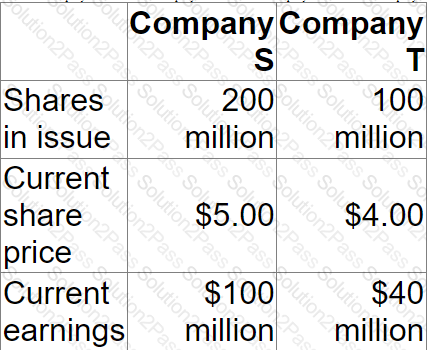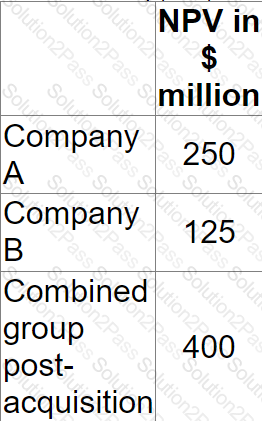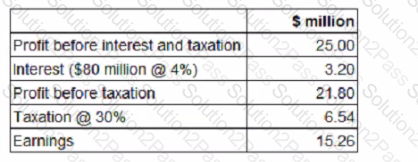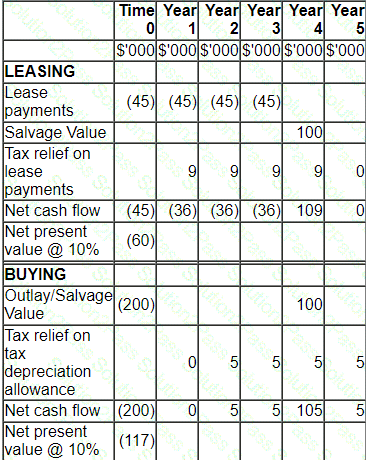F3 CIMA Financial Strategy Free Practice Exam Questions (2025 Updated)
Prepare effectively for your CIMA F3 Financial Strategy certification with our extensive collection of free, high-quality practice questions. Each question is designed to mirror the actual exam format and objectives, complete with comprehensive answers and detailed explanations. Our materials are regularly updated for 2025, ensuring you have the most current resources to build confidence and succeed on your first attempt.
A large, listed company in the food and household goods industry needs to raise $50 million for a period of up to 6 months.
It has an excellent credit rating and there is almost no risk of the company defaulting on the borrowings. The company already has a commercial paper programme in place and has a good relationship with its bank.
Which of the following is likely to be the most cost effective method of borrowing the money?
A company has a financial objective of maintaining a gearing ratio of between 30% and 40%, where gearing is defined as debt/equity at market values.
The company has been affected by a recent economic downturn leading to a shortage of liquidity and a fall in the share price during 20X1.
On 31 December 20X1 the company was funded by:
• Share capital of 4 million $1 shares trading at $4.0 per share.
• Debt of $7 million floating rate borrowings.
The directors plan to raise $2 million additional borrowings in order to improve liquidity.
They expect this to reassure investors about the company's liquidity position and result in a rise in the share price to $4.2 per share.
Is the planned increase in borrowings expected to help the company meet its gearing objective?
Company S is planning to acquire Company T.
The shareholders in Company T will receive new shares in Company S in an all-share consideration.
Relevant information:

The shareholders in Company T want sufficient shares to receive a 25% premium on the pre-acquisition value of their shares, based on the pre-acquisition share price.
Which of the following share-for-share offers will achieve the desired result?
A profitable company wishes to dispose of a loss-making division that generated negative free cashflow in the last financial year.
The division requires significant new investment to return it to profitability.
Which of the following valuation approaches is likely to be the most useful to the company when negotiating the sales price?
NNN is a company financed by both equity and debt. The directors of NNN wish to calculate a valuation of the company's equity and at a recent board meeting discussed various methods of business valuation.
Which THREE of the following are appropriate methods for the directors of NNN to use in this instance?
Company A is planning to acquire Company B by means of a cash offer. The directors of Company B are prepared to recommend acceptance if a bid price can be agreed. Estimates of the net present value (NPV) of future cash flows for the two companies and the combined group post acquisition have been prepared by Company A’s accountant. There are as follows:

What is the maximum price that Company A should offer for the shares in Company B?
Give your answer to the nearest $ million

A company has a covenant on its 5% long-term bond, stipulating that its retained earnings must not fall below $2 million.
The company has 100 million shares in issue.
Its most recent dividend was $0.045 per share. It has committed to grow the dividend per share by 4% each year.
The nominal value of the bond is $60 million. It is currently trading at 80% of its nominal value.
Next year's earnings before interest and taxation are projected to be $11.25 million.
The rate of corporate tax is 20%.
If the company increases the dividend by 4%, advise the Board of Directors if the level of retained earnings will comply with the covenant?
Country X's short-term interest rates are slightly higher than its long-term rates. Which THREE of the following statements are correct?
JAG and ZEB are two listed companies. JAG is approximately 20 times the size of ZEB.
10 days ago JAG made a hostile bid for ZEB. offering a share exchange.
The bid price represents a 10% profit to the shareholders of ZEB at today's market prices to reflect the high levels of synergistic benefits that JAG expects to realise from the transaction.
Which of the following is the greatest future threat to the post-transaction value for JAG?
A company is deciding whether to offer a scrip dividend or a cash dividend to its shareholders.
Although the company has excellent long-term growth prospects, it is experiencing short-term profit and cash flow problems.
Which of the following statements is most likely to be a reason for choosing the scrip dividend?
Company A plans to acquire Company B.
Both firms operate as wholesalers in the fashion industry, supplying a wide range of ladies' clothing shops.
Company A sources mainly from the UK, Company B imports most of its supplies from low-income overseas countries.
Significant synergies are expected in management costs and warehousing, and in economies of bulk purchasing.
Which of the following is likely to be the single most important issue facing Company A in post-merger integration?
A national rail operating company has made an offer to acquire a smaller competitor.
Which of the following pieces of information would be of most concern to the competition authorities?
A company has a 4% corporate bond in issue on which there are two loan covenants.
• Interest cover must not fall below 4 times
• Retained earnings for the year must not fall below S5 00 million
The Company has 100 million shares in issue. The most recent dividend per share was $0 10 The Company intends increasing dividends by 8% next year.
Financial projections tor next year are as follows:

Advise the Board of Directors which of the following will be the status of compliance with the loan covenants next year?
A company plans to raise finance for a new project.
It is considering either the issue of a redeemable cumulative preference share or a Eurobond.
Advise the directors which of the following statements would justify the issue of preference shares over a bond?
A company generates operating profit of $17.2 million, and incurs finance costs of $5.7 million.
It plans to increase interest cover to a multiple of 5-to-1 by raising funds from shareholders to repay some existing debt. The pre-tax cost of debt is fixed at 5%, and the refinancing will not affect this.
Assuming no change in operating profit, what amount must be raised from shareholders?
Give your answer in $ millions to the nearest one decimal place.
$ ?
A national airline has made an offer to acquire a smaller airline in the same country.
Which of the following would be of most concern to the competition authorities?
A listed entertainment and media company produces and distributes films globally. The company invests heavily in intellectual property in order to create the scope for future film projects. The company has five separate distribution companies, each managed as a separate business unit The company is seeking to sell one of its business units in a management buy-out (MBO) to enable it to raise finance for proposed new investments
The business unit managers have been in discussions with a bank and venture capitalists regarding the financing for the MBO The venture capitalists are only prepared to invest a mixture of debt and equity and have suggested the following:

The venture capitalists have stated that they expect a minimum return on their equity investment of 3Q°/o a year on a compound basis over the first 5 years of the MBO No dividends will be paid during this period.
Advise the MBO team of the total amount due to the venture capitalist over the 5-year period to satisfy their total minimum return?
A venture capitalist is most likely to take which THREE of the following exit routes?
An unlisted software development company has recently reported disappointing results. This was partly due to weak economic conditions but also because of its poor competitive position. The company has a number of exciting development opportunities which would enable it to achieve significant future growth. The company's growth potential has been hindered by its inability to secure sufficient new finance.
To enable the company raise new finance the Directors are considering working forwards an IPO in 10 years and accepting finance from a venture capitalist in order support in the intervening period.
The directors are keen to retain a controlling stake in the company and full representation on the board. They therefore require venture capitalists to provide funds as a mix of debt and equity and not soley equity finance.
Which THREE of the following are most likely to disrupt the directors' plans to use venture capital finance?
A company plans a four-year project which will be financed by either an operating lease or a bank loan.
Lease details:
• Four year lease contract.
• Annual lease rentals of $45,000, paid in advance on the 1st day of the year.
Other information:
• The interest rate payable on the bank borrowing is 10%.
• The capital cost of the project is $200,000 which would have to be paid at the beginning of the first year.
• A salvage or residual value of $100,000 is estimated at the end of the project's life.
• Purchased assets attract straight line tax depreciation allowances.
• Corporate income tax is 20% and is payable at the end of the year following the year to which it relates.
A lease-or-buy appraisal is shown below:

Which THREE of the following items are errors within the appraisal?


